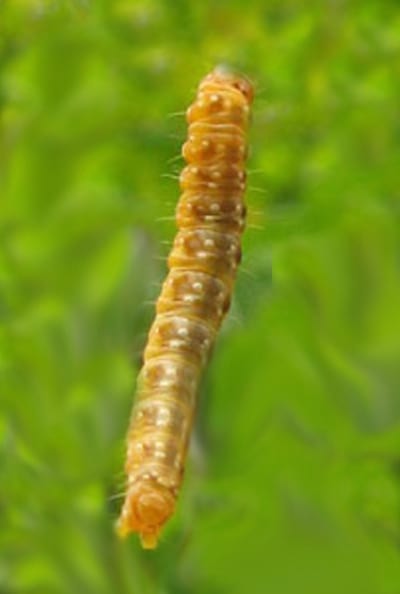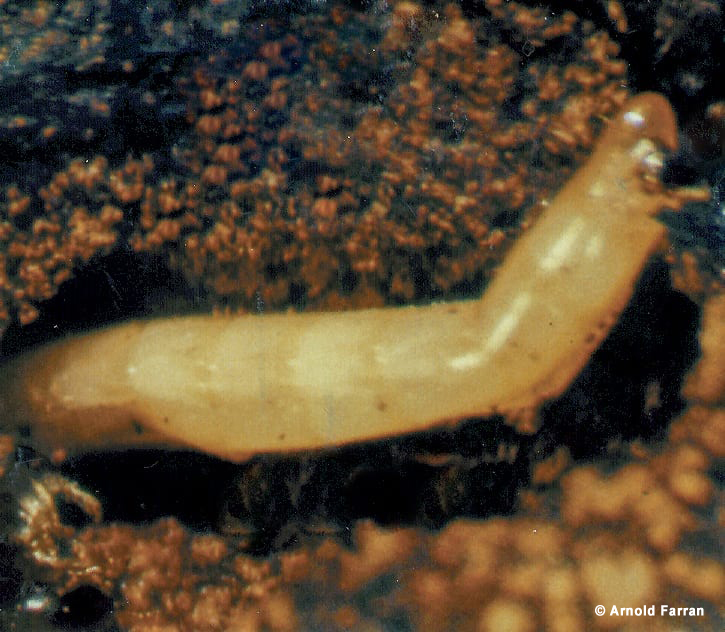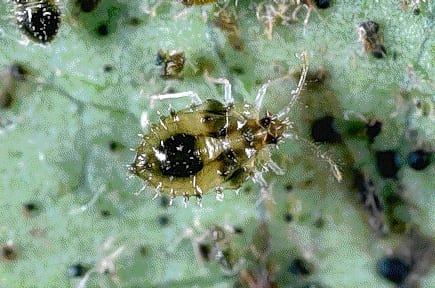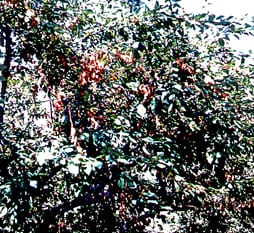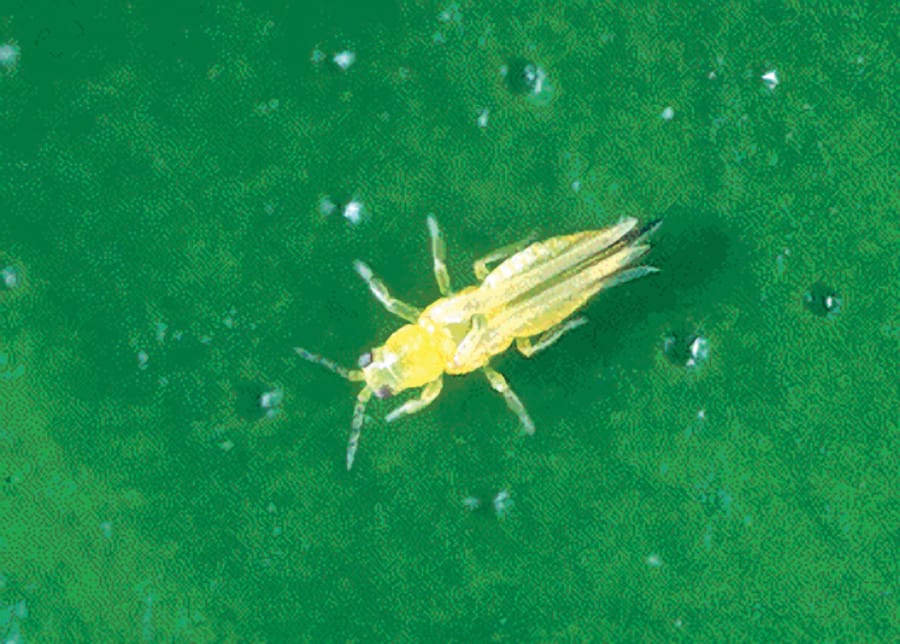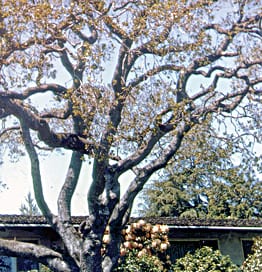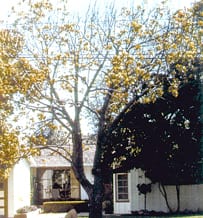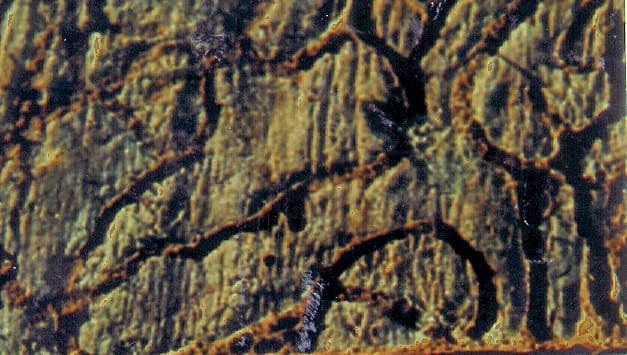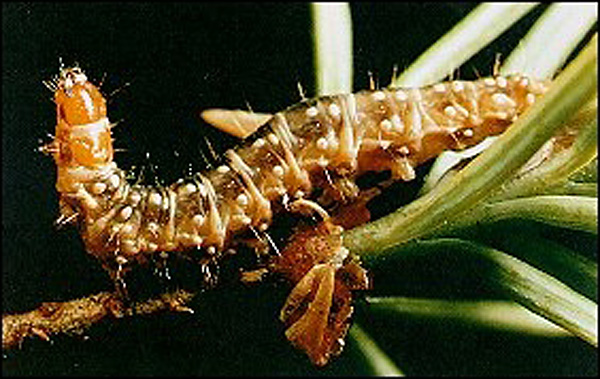WESTERN SPRUCE BUDWORM (Choristoneura occidentalis Freeman)
The western spruce budworm, is the most widely distributed and destructive defoliator of coniferous forests in Western North America. It is one of nearly a dozen Choristoneura species, subspecies, or forms, with a complexity of variation among populations found throughout much of the United States and Canada. It occurs in the Rocky Mountains from Arizona and New Mexico northward into Colorado, Utah, Wyoming, Montana, and Idaho; in the Pacific Northwest in Oregon and Washington; and in British Columbia and Alberta, Canada.
IDENTIFICATION:
Adult moths are about 12.7 mm long and have a wingspread of 22 to 28 mm. Moths of both sexes are similar in appearance, although the females are a bit more robust than males. Both sexes fly. The gray- or orange-brown forewings are banded or streaked, and each usually has a conspicuous white dot on the wing margin. Eggs are oval, light green, and about 1.2 mm long and overlap like shingles.
Larvae develop through six stages. Newly hatched larvae are yellow-green with brown heads. In the next three stages, larvae have black heads and collars and orange- or cinnamon-brown bodies. In the fifth stage, larvae have reddish-brown heads marked with black triangles, black collars, and pale olive-brown bodies marked with small whitish spots. Mature larvae (see cover) are 1 to 1¼ inches (25 to 32 mm) long, with tan or light chestnut-brown heads and collars and olive- or reddish-brown bodies with large ivory-colored areas. Pupae are 13 to 16 mm long, broad at the head end, and narrower toward the tail. They are brownish-yellow or brownish-green at first, and later turn reddish-brown
LIFE CYCLE:
Throughout most of its range, the western spruce budworm completes one cycle of development from egg to adult within 12 months. Moths emerge from pupal cases usually in late July or early August; in the southern Rockies, adults often begin emerging in early July. The adults mate, and within 7 to 10 days, the female deposits her eggs and then dies.
Each female deposits approximately 150 eggs, usually on the underside of conifer needles. Eggs are laid in one- to three-row masses containing a few to 130 eggs, with an average of 25 to 40 eggs per mass. Females usually lay some eggs at the site where they emerge and mate, then disperse to deposit their remaining eggs.
Larvae hatch from eggs in about 10 days. Larvae do not feed, but seek sheltered places under bark scales or in and among lichens on the tree bole or limbs. Here, they spin silken tents called “hibernacula” in which they remain inactive through the winter.
In early May to late June, larvae leave their hibernacula to search for food. They first mine or tunnel into year-old needles, closed buds, or newly developing vegetative or reproductive buds. Larvae usually leave traces of silken webbing and bits of excrement at the feeding site or entrance hole (fig. 6). As new shoots flush, larvae spin loose webs among the needles and feed on the new foliage. As shoots continue to elongate and needles develop, adjacent shoots often are webbed together by the larvae and begin to appear twisted or stunted. New foliage, which is normally the preferred food, is usually entirely consumed or destroyed before larvae will feed on older needles. On some hosts, larvae favor developing male flowers and conelets as food, and on western larch, larvae mine and sever the terminal and lateral shoots.
Larvae become full grown usually in early July about 30 to 40 days after leaving their overwintering sites. As larvae mature, the webbed branch tips on which they have fed begin to turn reddish brown (fig. 7). Larvae pupate in webs of silk they have spun either at the last feeding site or elsewhere on the tree. The pupal stage usually lasts about 10 days.
HOST TREES:
The most common host-tree species of the western spruce bud-worm are: Douglas-fir (Pseudotsuga menziesi (Mirb.) Franco), grand fir(Abies grandis (Doug. ex D. Don) Lindl.), white fir (Abies concolor (Cord. and Glend.) Lindl. ex Hildebr.), subalpine fir (Abies lasiocarpa (Hook.) Nutt.), corkbark fir (Abies lasiocarpa var. arizonica (Merriam) Lemm.), blue spruce (Picea pungens Engelm.), Engelmann spruce (Picea engelmannii Parry ex Engelm.), white spruce (Picea glauca (Moench) Voss), and western larch (Larix occidentalis Nutt.). Larvae feed occasionally on Pacific silver fir (Abies amabillis Dougl. ex Forbes), mountain hemlock (Tsuga mertensiana (Bong.) Carr.), western hemlock (Tsuga heterophylla (Raf.) Sarg.), lodgepole pine (Pinus contorta var. latifolia Englem.), ponderosa pine (Pinus ponderosa Dougl. ex Laws.), western white pine (Pinus inonticola Dougl. ex D. Don), limber pine (Pinus flexilis James), and whitebark pine (Pinus albicaulis Engelm.). Some of these tree species are also hosts of other closely related species of Choristoneura whose populations sometimes occur simultaneously with the western spruce budworm.
Often budworm larvae feed on and seriously damage coniferous trees that are planted as ornamentals, such as Norway spruce (Picea abies (L.) Karst., and Scotch pine (Pinus sylvestris L.).
DAMAGE:
Cones and seeds. – In addition to foliage, budworm larvae feed heavily on staminate flowers and developing cones of host trees (fig. 8). The resultant decline in seed production has a serious impact in seed orchards, seed production areas, and forest sites that are difficult to regenerate naturally. Moreover, artificial regeneration practices are affected because seed is not available for nurseries or direct seeding.
Unlike some cone and seed insects, budworm larvae do not always restrict their feeding to a single cone. Often, second- or third-stage larvae feed on newly developing conelets that soon shrivel up, dry out, and fall from the tree. As these cones dry out and become unsuitable for food, larvae continue feeding on other cones or on foliage.
In some Douglas-fir stands, nearly all cones may be damaged or destroyed by feeding larvae, especially when larval population densities are high and cone crops are light. Top-killing of some host trees, as a result of persistent heavy defoliation, often precludes cone production for many years, even when budworm populations subside.


